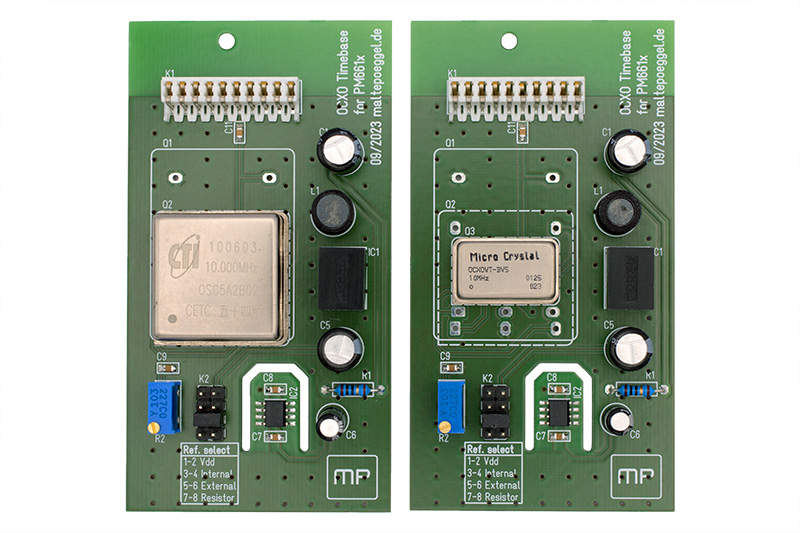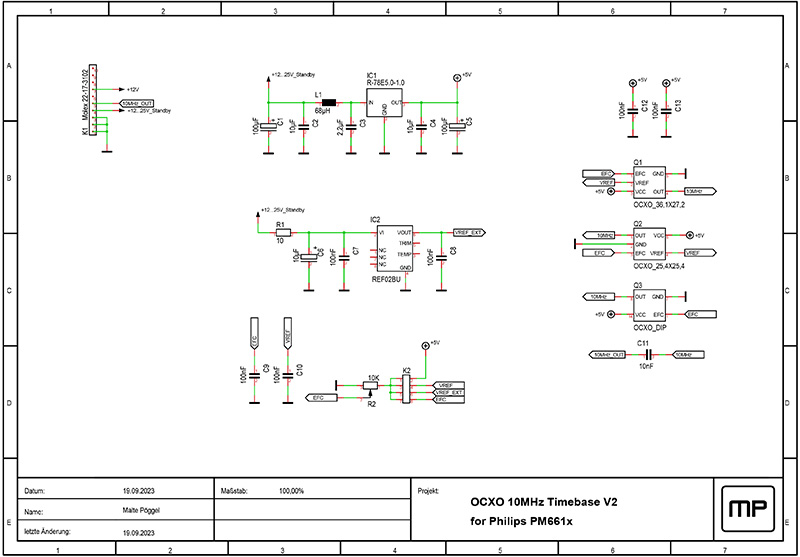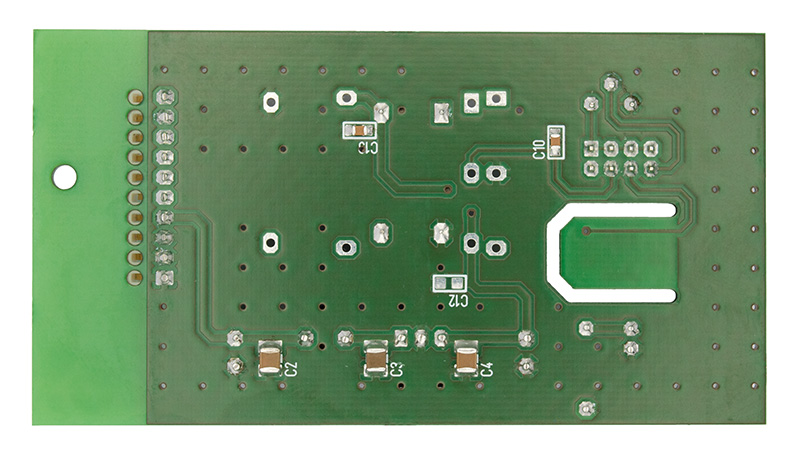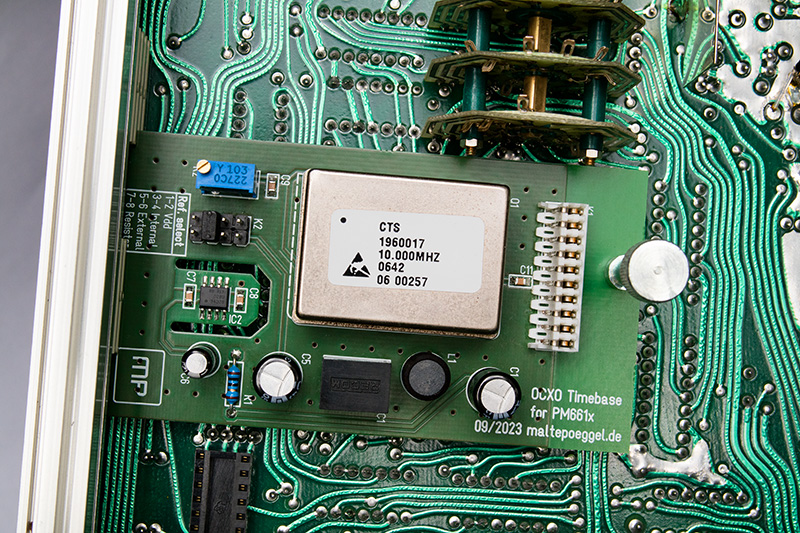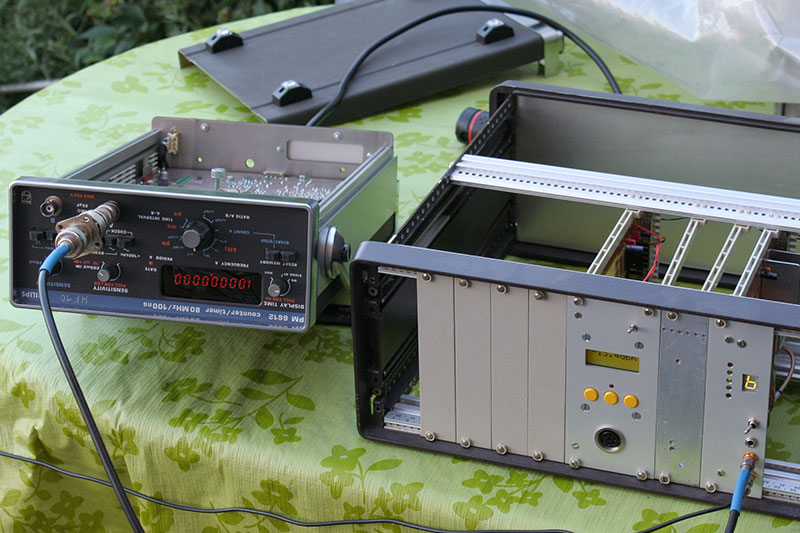OCXO Timebase
New time base module for Philips frequency counters using a quartz oven
When measuring with my Philips frequency counter PM6612, I always noticed small deviations. This is no surprise when using the basic quartz time base PM9677 - it has never been calibrated since I bought it and is also subject to deviations due to temperature changes and aging of the quartz. Philips offered other versions of the time base for the counter at that time. The accuracy could be increased with a temperature compensated quartz oscillator (TCXO) or better quartz oven (OCXO). In this case, the deviations are either compensated electronically based on the characteristic curve, or in case of the latter, the quartz is brought to a defined temperature. The original Philips OCXO time base modules are unfortunately very rare and thus very expensive or difficult to obtain. Therefore I decided to build one myself.
At the heart of the new time base is an Ovenized Crystal Oscillator (OCXO), whereby different types and designs are supported. If you are lucky, you can find a suitable quartz oscillator at well-known online auction houses or Chinese Surplus dealers. It is mandatory that the OCXO is tunable via an external voltage. If the necessary reference voltage is not led out, an external precision voltage reference can be assembled and used.
Circuit description
The frequency counter internally provides two voltages: A permanently present, unregulated DC voltage between 12 and 25V and a regulated 12V voltage, which is only present when switched on. The original OCXO module uses the unregulated voltage to keep the quartz oven continually heated, even in stand-by. To avoid a warm-up time, this is also used in my setup. An efficient step-down switching regulator (IC1) generates the necessary 5V to operate the crystal oven. The preconnected LC low-pass filter (C2, L1, C3) filters out electromagnetic interference. This is dimensioned according to the manufacturer's specifications. The optional precision reference voltage source (IC2) of type REF02BU can be fitted if the quartz oven does not supply its own reference voltage. It has a low temperature drift and is also thermally decoupled by a slot in the circuit board. The operating voltage is filtered here by an RC low-pass filter consisting of R1 and C6. The reference is selected via jumper K2. Here you can choose between supply voltage, internal reference, external reference and the configuration as resistor. The fine adjustment of the frequency is done by the 25-turn trimmer potentiometer R2. Space for different quartz ovens is provided by the footprints Q1 (36.1*27.2mm), Q2 (25.4*25.4mm) and Q3 (DIP14).
Some SMD capacitors are located on the backside of the board.
Selection of suitable quartz ovens
The following table presents a selection of compatible OCXOs. The waveform is irrelevant, since the input section in the frequency counter converts the signal of the oscillator into a square wave signal by using a Schmitt trigger anyway. Before installing unknown quartz oscillators, the pin assignment should be checked at any case.
Also quartz oscillators with 12V operating voltage are possible. For this purpose the switching regulator as well as the preconnected filter must be adapted according to the note in the BOM. The external reference voltage source can be replaced by a 10V reference (REF102BU) if necessary.
| Type | Operating voltage | Waveform | Footprint | Int. reference | Pos. jumper |
|---|---|---|---|---|---|
| CTS 970-2178-46 | 5 Volt | Sine | Q1 | yes | 3-4 |
| CTS 1960017 | 5 Volt | Sine | Q1 | yes | 3-4 |
| Abracon AOCJY4A | 5 or 12 Volt | dep. on model | Q1 | yes | 3-4 |
| NDK ENE3311B | 5 Volt | Square | Q2 | no | 5-6 |
| CTI OSC5A2B02 | 5 Volt | Square | Q2 | no | 5-6 |
| Abracon AOCJY3A | 5 or 12 Volt | dep. on model | Q2 | yes | 3-4 |
| MC OCXOVT-BV5 | 5 Volt | Square | Q3 | no | 5-6 |
| MC OCXOVT-BR1 | 5 Volt | Square | Q3 | no | 7-8 |
Installation
The module is located on the main board of the device and can be mounted in a few steps after opening the lower half of the case.
Adjustment
A frequency standard is required to calibrate the time base. For example, this can be a GPS Disciplined Oscillator (GPSDO) or Rubidium Oscillator. If the module is already installed into the frequency counter, the reference clock is simply applied to the input of the counter. After the setup has warmed up for several hours, the counter is first coarsely adjusted with the shortest gate time. The fine adjustment is done after selecting the longest time constant to display exactly 10 MHz.
For an adjustment outside the frequency counter, the reference frequency can be fed in via the socket on the rear panel. The selection of the external time base is done by the switch next to it. The time base module to be adjusted is connected to the input and calibrated as usual.
Conclusion
By using my module, Philips frequency counters like PM6611, PM6612, PM6613, PM6614, PM6615 and PM6616 can be easily and inexpensively equipped with a very accurate reference. Most modern OCXOs have excellent short term stability and should be equivalent or even better than the original quartz PM9690.
Have a lot of fun building your own!
Download
- Schematic (PDF)
- Bill of material (PDF)
- Layout and BOM
- Layout in Gerber format
- Circuit board at Aisler
- Circuit board at OSH Park
- Datasheet OCXOVT-BV5
There might be some boards and spare parts left from development. Drop me a message if interested.
Related projects
- The Sync Channel Blog - PM66xx Frequency Counter OCXO Upgrade
- EEVBlog - PM6665/PM6669 OCXO upgrade
- Jackenhack - PM6665 Frequency Counter with Oven Controlled Crystal Oscillator
- M. Knietzsch - List of various OCXO pinouts
License
The PCB layout I created may be used freely for private use, but the author's name must remain on it (CC BY-NC-SA).

